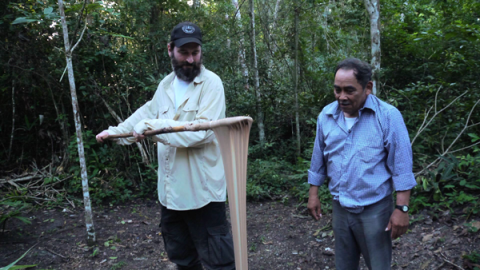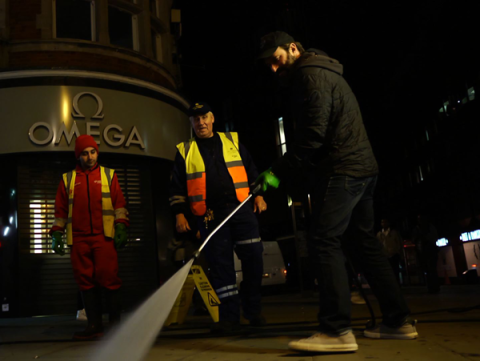
But film director and environmentalist Andrew Nisker does not expect you to give up gum. The Toronto documentarian behind Dark Side of the Chew just wants you to put it in the trash when you’re done. And if gum manufacturers could come up with a formulation that proved to be less sticky — therefore a lot easier to clean up — as well as recyclable packaging, he’d be a happy man.
Those are two of the big takeaways from Dark Side of the Chew, a funny but sometimes frightening look at the history of gum and its impact on our lives. It was during the making of Nisker’s first doc, Garbage! The Revolution Starts At Home (2007), about one family’s attempts to reduce the amount of garbage they produce, that Nisker discovered the statistic about gum litter. A story idea was born.
His researches took him to Finland (to see gum 5,500 years old); Mexico (to talk to farmers trying to bring back biodegradable gum); London, England (to talk to businesses who spend millions annually to clean gum off their sidewalks); and back to Toronto (to take on the claims of manufacturers that chewing gum aids students’ concentration).
Nisker traces the modern history of gum from its origins as a by-product of tree sap through its popularization in the ‘40s among American soldiers during WWII when Wrigley gum became part of their K rations. We then see how, through clever marketing and mass manufacturing (which replaced natural chicle with plastics like polyisobutene, which gives gum its elasticity and is a popular engine lube), gum became not only an amazing success story but an environmental nuisance that sloughs toxins into the watershed and creates tons of unrecyclable packaging.
But there is a lighter side to Dark Side of the Chew. Nisker visits the British company Revolymer, which is working on gum that doesn’t stick, and Chicza, a Mexican company that harvests chicle in a sustainable way. (Chicza Mayan Forest Organic Gum is not currently available in Canada.) Nisker, who has recently launched a political career (he’s running as a Liberal candidate in Beaches-East York), is also hopeful that his documentary will remind consumers that all those black spots on the sidewalk could be avoided if they just disposed of gum properly: in the trash.
Samaritanmag spoke to Nisker shortly after his film’s debut at the Planet in Focus festival in Toronto in November. Dark Side of the Chew will also be broadcast by TVO this winter (airdates to be confirmed).
How important was gum to you growing up?
“We never thought about these things. I chewed everything I could get my hands on, from gum balls to jawbreakers, which had gum in the middle. And of course I remember buying my favourite packs of Big League Chew or the Gold Nugget gum you used to get that resembled gold nuggets. On top of that, there’s the bubble gum with the comics. So all that stuff is definitely a memory of my childhood and a fond memory of my childhood.”

“We researched the history of gum itself; how gum became something everyone loved to buy and chew. It’s an incredible lesson in the history of mass-marketed products, and it’s one of the first mass-marketed products ever. And there were a lot of lessons to be learned from that story. When we pitched, we spoke about how gum was manufactured, how it was brought to market, how it was sold, and, of course, where we’re at today in terms of the impact of gum on the environment. Broadcasters seemed to be excited by the overall package I presented.”
Gum has been masterfully marketed for qualities it may or may not have, like supposedly helping kids concentrate. Do you hope this film acts as a counteractive to those claims?
“I hope it gets people to start questioning what they put in their mouths and to start thinking about the damages it does to the environment because all-around as a product, the packaging you can’t recycle, the gum itself is causing environmental issues, causing great economic burden on municipalities and businesses to remove it. The whole thing has to be re-examined, and I am hoping that the film will raise awareness so people stop littering because obviously consumers are to blame for throwing the stuff on the ground, and the manufacturers continue to ramp up their quest to find something that is more sustainable.
“It’s one thing that gum sticking to sidewalks is an issue because the gum formulations are as they are, but there’s no reason why the packaging should be so environmentally damaging; the packaging itself in terms of not being able to be recycled. It’s just pure litter when it’s done with. I would like to see a more eco-friendly packaging at least to start with. I know there’s been hundreds of millions of dollars put into R&D [research and development] to create some kind of biodegradable gum, and they still haven’t come up with a formulation.
Anyways, at the end of the day that’s what we want people to do. This is a sneaky way of getting people to think about, or our children to think about, the life cycle of products and sustainability and how what we do on a day-to-day level affects our environment.”
Q&A CONTINUES AFTER NISKER'S TEDX TALK VIDEO:
You cover sustainable efforts to manufacture organic chicle gum in Mexico. Obviously organic gum will never supplant plastic gum. Does that fact depress you or does it inspire hope that there are still people around who want to do good for the world?
“We’re always looking for a silver lining when we make these films, and these were particularly strong stories for me. I travelled very far and took a lot of risks to go get that information and meet those people. And for me it was very encouraging, and hopefully for audiences too. So when we find individuals like that who are working to do the right thing, it definitely gives us hope.”
What are the environmental impacts of gum on the animal population?
“There haven’t been a lot of studies done so we didn’t find an expert who had done any specific research on that. But, on the larger scale, gum is plastic, and plastic going into the watershed causes a whole host of environmental issues. Pollution in the watershed, it acts like a sponge; it absorbs toxins and gets into the food chain; it gets eaten by aquatic life. And that’s a major concern because obviously water is the basis of life, and if we’re polluting it with plastic and it’s getting into the food chain, that’s a huge concern for all animals, including us at the top of the food chain.
“And there’s obvious environmental issues that happen when birds get stuck in gum on pavement, or animals eat gum. Again, we couldn’t find any strong studies done yet in terms of how it affects squirrels or birds, but as we were told in Mexico, there were issues about sticking gum to trees so they were discouraging that practice. But, as you can imagine with gum litter everywhere, there is definitely some impact on wildlife.”
You conducted an unscientific experiment with students at a Toronto middle school where you tested claims that gum chewing increased student concentration. The results cast doubt on those claims. What impact do you hope this documentary has on those who watch it, including the kids in that experiment?
“I just screened the film for the school where we did our experiment [Nisker prefers not to mentioned the name], and I was there for parent-teacher interviews and I had a bunch of kids come up to me. ‘You’re the guy in the film! Oh my God, that was disgusting!’ It really had an impact, and they all seemed to remember it. I bumped into some of their parents too; they were like, ‘The kids came home and they talked non-stop about chewing gum and the environmental impact of it.’
“So there you go; it has definitely made its mark. Now our challenge is to get our message out there and get our trailer online, share it through social media circles. Contact us, get copies of the film and host screenings, and let’s get the story out there.”

“If everyone did a small thing in their lives, like switching from bottled water to tap water, or reducing their bottled water consumption by 80 percent, if everyone did that it would have a massive impact on the environment.
“And so I’m a believer that the revolution starts at home, and that’s the tagline of my first film, Garbage! Every little change that we do in our home has a big impact on the outside world, and if everybody made those changes in terms of use less toxic chemicals to clean their homes, reduce the amount of plastic that they use, put their gum in the trash bin, that would force manufacturers to change the formulation of their products. That’s voting with your pocketbook.
“You can’t rely on industry or government to make a massive difference. They might eventually, but if consumers start their own revolution, that can make a big difference in terms of how we as a society overall affect the environment.”
You are also running as a Liberal candidate in the Toronto riding of Beaches-East York. Do you see politics as a logical extension of your filmmaking in terms of having an impact on your community and the world around you?
“One of my favourite things about making these films is going out and engaging with audiences about the impact they can make through engaging their communities into watching these stories and take action. And so I felt at this point in my life there was a great opportunity to become a part of something that I firmly believe will make a difference. There’s going to be a huge shift politically in this country, and I like what Justin Trudeau is standing for, and I like that he has surrounded himself with former World Wildlife [Fund] executives Gerry Butts, the former president of the World Wildlife Fund, [and] Christina Topp, one of their head fundraisers. And I definitely feel like there will be excitement and a willingness to fight for the environment that hasn’t been seen in Ottawa in probably ever.
“So I want to be part of that. And if I win the nomination and win the federal election, perhaps I can whisper in someone’s ear and make a difference.”
What would you do if you saw someone toss out their gum onto the sidewalk?
“What would I do? That’s a good question. I’d tell them to watch my movie.”
adidas rokadia pants for women black green